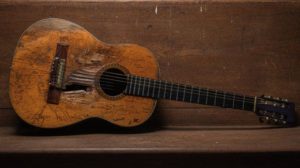
For my upcycle project, I decided to make a miniature acoustic guitar. I don’t play guitar (not very well at least) but I’ve always found them to be very well crafted and aesthetically pleasing. My dad plays guitar and I’ve grown up looking at his sitting around the living room.
I experimented with a few different materials (wood and plastic) but creating the curvature on the side of the guitar would have been extremely difficult. Below are some images of how a stencil was used to cut out the shape of the guitar body and the fretboard.

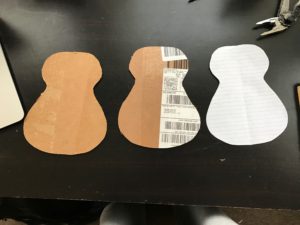
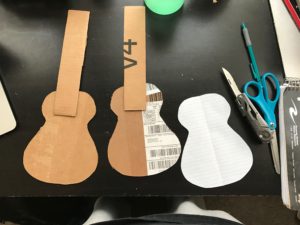
These first parts are made out of cardboard from the box that my textbooks came in. If you look closely, you can even see my name and address conveniently placed on the front of the body. I decided to leave this portion of the label facing outward to give some unique design to the guitar. It kind of acts as a reminder that the project is upcycled garbage.
Piecing together the body and sides was the tricky part. My original goal was to try to seal the inside edges so some sound might resonate but that proved to be more difficult than I anticipated.
To piece together the two body faces, I bent smaller pieces of cardboard into a pieces that I called a “bridge.” These pieces were taped and glued down to both faces.
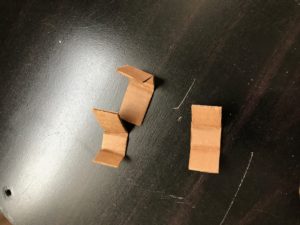
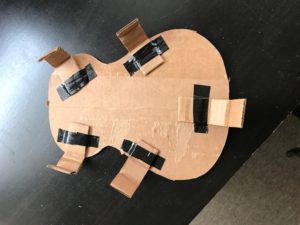
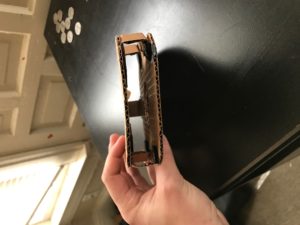
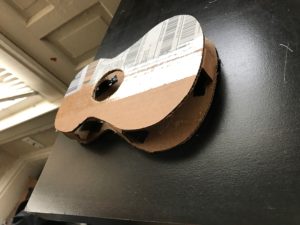
When taped to both faces, these bridge pieces created perpendicular faces that I could use to attach the curved side pieces. I ended up adding a few more of the bridge pieces after this picture to add a little bit more stability and more surface area.
To make the curved sides of the guitar, I had to use a slimmer material so that creases would not be created. I used some cardboard from cereal boxes and a box of cliff bars that I had lying around my room. These pieces actually turned out to work very well.
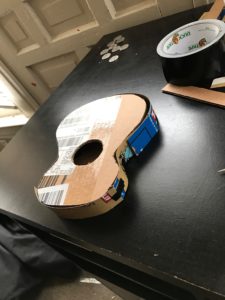
The sides were cut and glued to each bridge piece. I had to use small pieces of tape to hold certain pieces together while the glue dried. You can see one of them in the picture above. With the sides attached, it was time to add the neck, headstock, and frets onto the guitar. These pieces were cut from the original, thicker cardboard. Frets, made of tooth picks, were glued onto the neck.
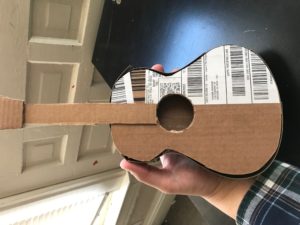
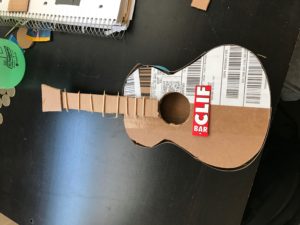
Lastly, I added a bridge by cutting the Cliff Bar logo from the box and gluing it to the body. I attempted to add strings made of floss to the guitar as part of the goal to make it resonate. However, I quickly abandoned these as adding tension to them resulted in the neck being pulled from the body. Overall, I’m happy with my project and most likely end up displaying it in my room. With more time I would have loved to find a way to bend wood and attempt to make a small ukulele.
(Anthony 2016 Spinditty. https://spinditty.com/instruments-gear/The-Parts-of-a-Guitar-What-Theyre-Called-and-Used-For)

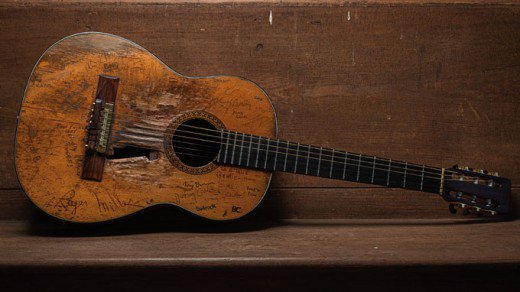
8 Comments. Leave new
I love the look with the shipping labels still on. It gives it a much more personal feel. I think it would be awesome if you found a way to seal it and make it sturdy enough to produce sound with it.
The patchwork look of the guitar looks great, you did a really good job of preserving the cardboard’s original look and incorporating it. I think this is a really good look for a guitar-a big part of a musician is his look, his aesthetic. They are often unique, having gathered influence from very different and unusual sources. A lot of musicians even decorate their guitars with stickers or a special paint job, making their guitar look similar to what you did here.
Great concept. You somehow achieved the scale and shape of the instrument very well. It really is too bad you couldn’t seal it off and hear its sound! If you wanted to in the future, paper mache might be a worthwhile rout. Another nice addition would be some strings! With it hanging on a wall, nobody would even know it didn’t make any worthwhile noise.
You did well in your creation of a musical instrument. It is no easy task…especially in terms of functionality. I think you did a great job of capturing the aesthetic though and I like your use of cliff bars. I also like that you went for the original shape of a guitar. I’d love to see you add strings (even if they’re not tensioned too).
Great idea! I like how you incorporated your name and address on the outside- makes it very individual and artistic. The Clif bar label is really cool. I like the size and shape- it looks well designed and constructed. Nice job!
I think this is a really cool project. It would have been even cooler if you could have figured out how to make it resonate. If you could actually play notes on a cardboard guitar it would be awesome. I think you should hold a mini concert and smash it.
Inspiration-great story behind why you chose this project. It was cool to hear the story behind your choice.
Leaving shipping label on is a great look. It’s not just plain cardboard and really looks like it’s been recycled.
Good use of rigid and flexible cardboard. Hopefully this will lead to bigger ideas and maybe you will make your own functional guitar.
Cool project. Too bad you couldn’t seal the cardboard to produce sound. The n seals on the cardboard was a cool idea